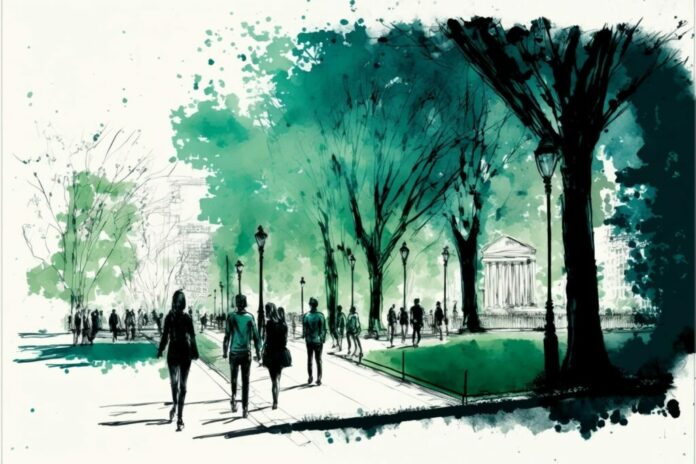Making public spaces healthier is of the utmost importance for countless communities around the world. When done effectively through evidence-based policies and grassroots advocacy, transforming public environments can vastly improve well-being, prevent chronic diseases, nurture sustainability, and bring people together.
Encouraging Active Transport: Connectivity, Safety and Amenities
One comprehensive strategy with immense benefits is encouraging active modes of transport like walking and cycling over private autos. Of course, this primarily means that cities need to have the infrastructure and amenities in place to make engaging in active transit easy, safe, convenient, and enjoyable for all. To that end, recommendations might include:
Infrastructure and Connectivity
- Building out safe, extensive walking and cycling lane networks. Paths should seamlessly connect to public transport hubs, workplaces, food outlets, green spaces and residential neighbourhoods, including both high- and low-income areas. Paths should be maintained for safety too.
- Having ample bike storage facilities across towns and cities so those cycling can securely park their wheels and gear.
- Developing bike-share schemes with docking stations across urban landscapes to further facilitate cycling for transport. These schemes help take cycle ownership barriers out of the equation.
- Closing off certain roads, especially in town and city centres, to make entire zones pedestrian- and cycle-only. Many urban areas worldwide with thriving bike cultures have used these ‘road diets’ successfully.
- Running ‘walking buses’ and walk/cycle to school programmes with adult supervision. This helps address traffic congestion around schools while building healthy lifelong habits for students.
Amenities and Safety
- Ensuring walking and cycling paths, and public spaces in general, have ample benches, bus shelters, clean and accessible toilets, and water fountains. This makes engaging in active transit more family-friendly, age-friendly, and appealing overall.
- Adding ample lighting to walking and cycling paths to enhance safety during darker hours. CCTV cameras also help address safety concerns.
- Planting trees and vegetation not just for aesthetic reasons but also to provide shade relief, absorb road noise/emissions and give paths a safety buffer from vehicles.
- Collaborating with police and neighbourhood watch groups to address crime or antisocial behaviour issues rapidly on footpaths or in public spaces like carparks, tunnels, etc. if problems appear. Perceptions and reality of safety issues can otherwise hinder usage and participation amongst more vulnerable groups like women, children, and seniors.
There are many benefits of well-planned infrastructure supporting active mobility over-reliance on private autos. For starters, enhanced walkability/bike-ability means far less traffic congestion and noise/air pollution from vehicles in communities. Importantly, enhanced active transit coupled with public transport accessibility helps more people easily incorporate exercise into their daily routines, which has been proven time again by public health research to benefit physical health and mental well-being.
Neighbourhoods designed for bikes and pedestrians also foster social connections and interactions on a human scale. Uplifting case studies abound globally. For example, in Amsterdam, cycling is ingrained in the culture, with over 70% of Amsterdam residents commuting via bike. The city’s cycling infrastructure and policies are now regarded as the gold standard globally. Nearby Copenhagen comes close with over 60% of residents cycling daily aided by cycling tracks spanning over 1000 kilometres. And car-clogged London and Manchester have made tremendous headway with cycling infrastructure expansions, seeing commuter participation rates rise yearly.
Discouraging Smoking in Public Spaces: Policy, Signage and Social Support
Another vital step in the mission to create healthier public spaces is developing cohesive policies and community partnerships to minimise exposure to second-hand smoke from tobacco in public spaces. We know from plenty of research that second-hand smoke is dangerous, especially for children, expecting mothers, those managing chronic illnesses, and seniors because of higher vulnerability. Multi-pronged strategies to prevent public smoking and enhance awareness include:
Policies and Partnerships
- Establishing clear national guidelines on smoke-free places, which municipalities can then adapt to local communities based on unique spaces, demographics, and needs. Parks, playgrounds, transport stops, town centre squares, and nightlife hubs should be priorities.
- Setting up designated disposable butt stops and smoking areas in distinct zones away from high-traffic public spaces yet still sheltered. Including benches and bins in these spots designates them for this purpose while keeping most spaces smoke-free. Smokers too need amenities, after all.
- Running positive public messaging campaigns on smoking’s negative health and social impacts with public health groups, schools and local area committees. This can help foster wider attitudinal change from young ages. Give smokers trying to quit free counselling support.
Awareness and Signage
- Install clear metal no-smoking signs in playgrounds, park entries, transport stops and busy town/city centre zones. Such consistent visual prompts work wonders for spreading awareness and expectations on smoke-free space policies. Embed no smoking symbols into footpaths approaching public spaces for extra visibility too.
- Post bigger gateway signs outlining smoke-free public space rules and reasons why at all major entrances – for example when entering expansive inner-city parks. Shopping centres and transport interchange hubs should have these too.
- Use murals or community noticeboards in public spaces to spell out smoke-free area rules paired with positive health messages. Local schools or artists can design these, making messaging relatable.
I started my business in Nairobi with Sh. 5 million capital, broke even after 5yrs
Enforcement Measures
- Local councils or agencies should have the mandate to enforce fines if needed for those repeatedly ignoring no-smoking zones, depending on policy frameworks. However, this enforcement method remains controversial to some given socioeconomic disparities. Critics argue stricter enforcement unfairly targets marginalised smokers unable to easily quit or with limited private outdoor space. Fines should hence start small if introduced and fund cessation support initiatives.
Conclusion
Creating healthier public spaces through infrastructure, amenities, and policies that promote active living and discourage smoking delivers immense benefits for community wellbeing. While substantial upfront investments are required from local and national governments, the positive impacts over the long term socially, environmentally, and economically make transforming public spaces a wise use of resources.
A collaborative effort between policymakers, urban planners, educators, and local communities is vital to bring the vision for healthier public realms alive in ways that uplift everyone. It simply takes leadership and coordinated action to make public health and sustainability a priority in how we design and manage shared spaces.








